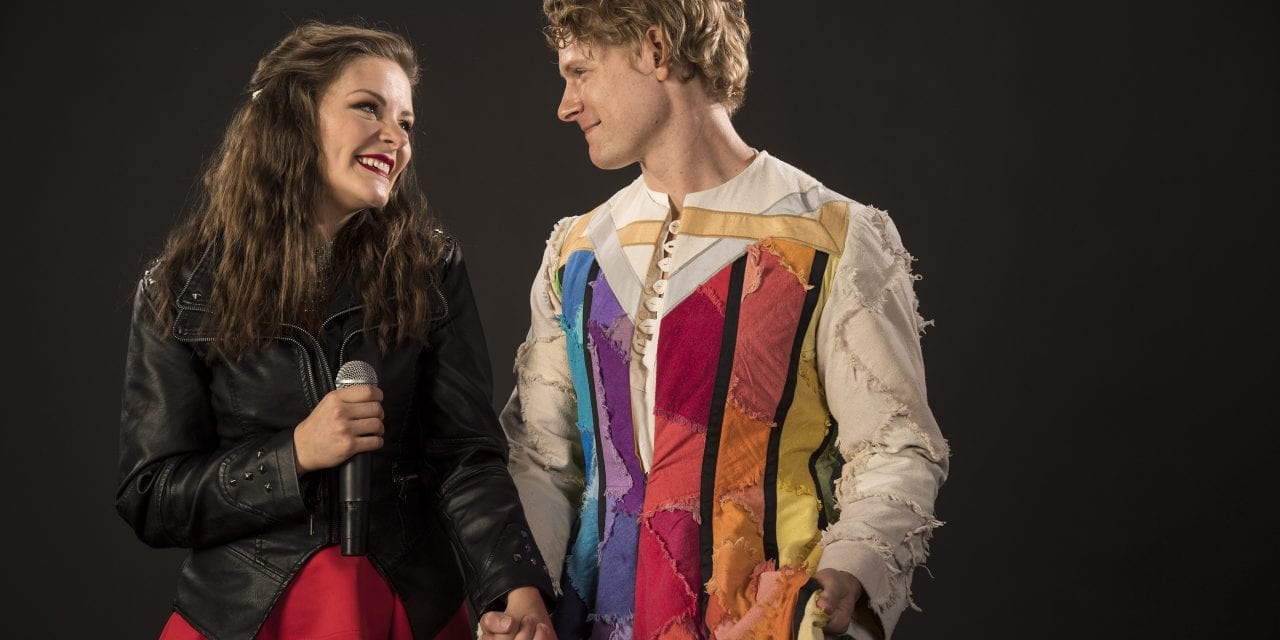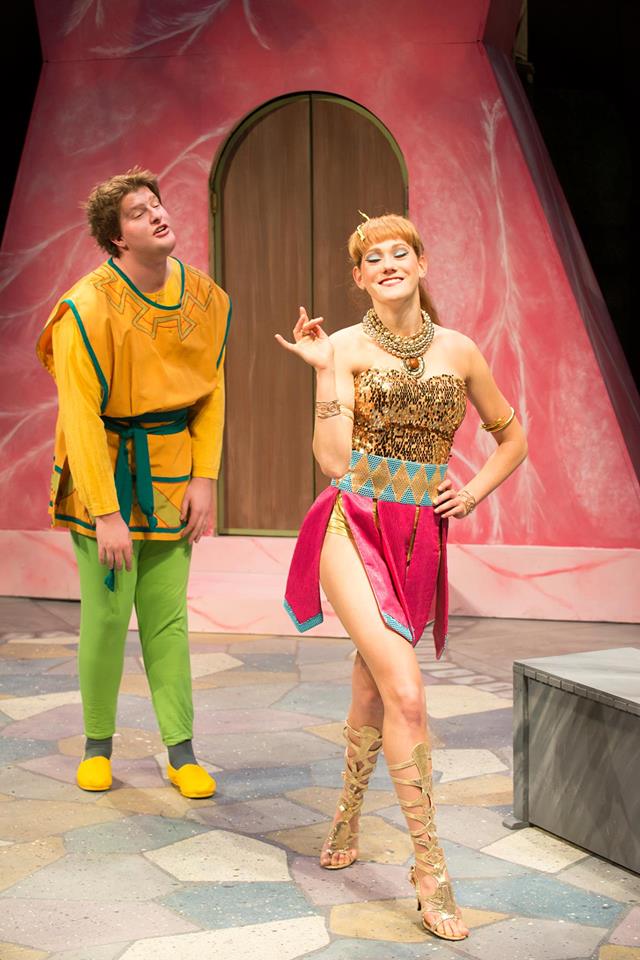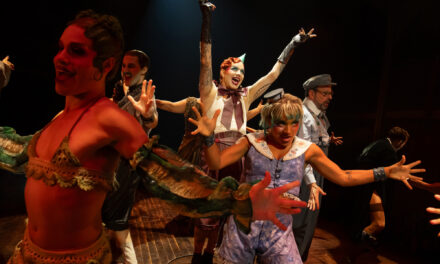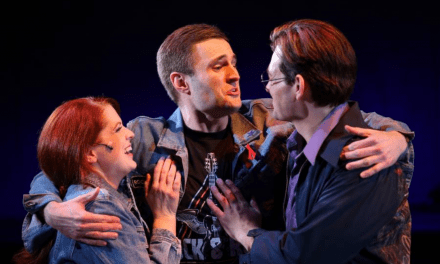CEDAR CITY — Joseph and the Amazing Technicolor Dreamcoat may be a groovy ’60s relic, but it feels energetic in a production currently playing at the Utah Shakespeare Festival. While loaded with charm and creativity, the production never becomes a spectacular smash.

Show closes October 12, 2019.
The ancient Greek philosopher Heraclitus stated that it is impossible to step into the same river twice. If he had been a theatre critic in Utah, he would have said that it is impossible to see Joseph twice. Directors of every production of this Utah-favorite look for any opportunity to find an innovative way to stage the musical numbers or slip a joke into the show. It’s one of the reasons audiences continuously come back to Joseph. Brad Carroll has packed this production with goodies that give even the most experienced theater-goer something new to enjoy. The backup singers during the song, “A Pharaoh’s Story,” the interactive camel, and A Chorus Line reference all struck me as particularly innovative. I could have easily chosen half a dozen other novel additions that Carroll created.
Carroll’s direction soars, but where Joseph falls short of his other successes at the Festival (like Murder For Two or Les Misérables) is in the choreography. Although the cast executes the steps well, Christine Kellogg‘s choreography never surpasses the complexity seen in many semi-professional productions of Joseph in Utah. The dancing in the song, “Joseph’s Coat,” consists almost entirely of turns and step-ball-changes, and the “Pharaoh’s Dream” choreography is mostly half-hearted grooving in place to the music. At the risk of stating the obvious: Joseph is a dance show. A professional production that fails to deliver professional-level choreography can never fulfill the play’s potential.

Lena Conatser (left), Hilary Alexa Caldwell, and Claudia Baffo as Pharaoh-ettes, and Samae Allred as Narrator in the Utah Shakespeare Festival’s 2019 production of Joseph and the Amazing Technicolor Dreamcoat. (Photo by Karl Hugh. Copyright Utah Shakespeare Festival 2019.)
Jason Lajka‘s set is another disappointment in this production. The fixed set pieces have a lovely stained glass motif that serves as a reminder that Joseph is a Biblical story. These pieces effectively absorb the colors of William C. Kirkham‘s kaleidoscopic lighting designs and are a pleasing anchor to the show. However, the set’s failures are in the fixed metal stairs and platforms and the movable pieces. The former are an unsightly metal skeleton in front of a dynamic backdrop, and the mobile pieces are usually underwhelming in their size and decoration. However, there are exceptions: the platform that Pharaoh (played by Russ Benton) stands on to sing, “Pharaoh’s Dream,” has the perfect amount of gaudy decoration, and the corrugated tin cacti in, “One More Angel,” are a nice accent.
Joseph’s name may be in the title, but the real star of the show is the narrator, played by Samae Allred. Andrew Lloyd Webber‘s score and Tim Rice‘s lyrics are tuneful almost to a fault, and Allred works with music director Jeremy Mann to create a performance that is reminiscent of a rock concert. Allred’s ease with her prop microphone and passion in, “Jacob and Sons,” or, “A Pharaoh’s Story,” makes her one of the most engaging narrators I have seen on stage. Allred has magnetism to spare, and I find nothing lacking in her work.

Aaron Young as Joseph in the Utah Shakespeare Festival’s 2019 production of Joseph and the Amazing Technicolor Dreamcoat. (Photo by Karl Hugh. Copyright Utah Shakespeare Festival 2019.)
Aaron Young plays Joseph as a self-conscious young man who is thrust into the roles of seer and savior for his family. This Joseph isn’t a Joseph who knows he’s the protagonist of a great story; rather, it’s a human Joseph who must cope with negative life circumstances. His pleas for the narrator not to leave him just before, “Close Every Door,” and subsequent sobbing are an emotional gut-punch that helps ease the show into its only character song. Young also has a lovely vibrato that adds a touch of maturity to the lighthearted score.
K. L. Alberts created wonderful costumes that mix the ancient with modern. The brothers wear Converse shoes with their more shepherds’ garb and have modern shirts under their robes. As a powerful ruler, Joseph has a golden breastplate and Egyptian headpiece paired with joggers and shiny tennis shoes. The anachronistic mix of clothing fits the show’s merging of ancient story with a modern twist. The only completely modern character, the narrator, has a delightful red asymmetrical skirt that accents her black jacket, boots, and leggings and adds to the rock vibe of the show.
One final strength of this production is the “Megamix” finale, which normally feels like an awkward 10-minute coda to the play. Carroll has turned this number into a rock sing-along. Audience members will enjoy it most if they clap along, sing their hearts out, and embrace the moment.
Nothing I can say will dissuade die-hard fans of Joseph and the Amazing Technicolor Dreamcoat from seeing this production, and those people will enjoy themselves. There’s a lot to enjoy about this production, even if the set and choreography make the show look cheap at times. Most Utahns have seen a Joseph or two that is as good as and as memorable as the Utah Shakespeare Festival’s production. This Joseph is satisfactory, but never has the polish and spectacle needed to make this anyone’s best Joseph ever.





